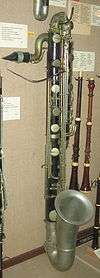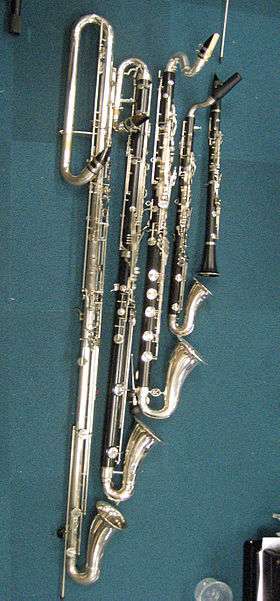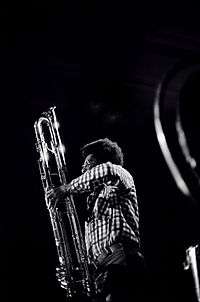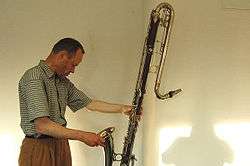Contrabass clarinet
|
Ernst Ulrich Deuker, a German jazz musician, with a Selmer contrabass clarinet | |
| Woodwind instrument | |
|---|---|
| Classification | Single-reed |
| Developed | 1808 |
| Playing range | |
|
| |
| Related instruments | |
| Musicians | |
| Musical instruments |
|---|
| Woodwinds |
| Brass |
| Percussion |
| String instruments |
| Keyboards |
The contrabass clarinet and contra-alto clarinet are the two largest members of the clarinet family that are in common usage. Modern contrabass clarinets are pitched in BB♭, sounding two octaves lower than the common B♭ soprano clarinet and one octave lower than the B♭ bass clarinet. Some contrabass clarinet models have a range extending down to low (written) E♭, while others can play down to low D or further to low C. Some early instruments were pitched in C; Arnold Schoenberg's Fünf Orchesterstücke specifies a contrabass clarinet in A,[1] but there is no evidence of such an instrument ever having existed.
The contrabass clarinet is also sometimes known by the name pedal clarinet, this term referring not to any aspect of the instrument's mechanism but to an analogy between its very low tones and the pedal division of the organ.
Subcontrabass clarinets, lower in pitch than the contrabass, have been built on only an experimental basis.
The EE♭ contra-alto clarinet is sometimes referred to as the "EE♭ contrabass clarinet".
History

Contrabass

The earliest known contrabass clarinet was the contre-basse guerrière invented in 1808 by a goldsmith named Dumas of Sommières; little else is known of this instrument. The batyphone (also spelled bathyphone, Ger. and Fr. batyphon) was a contrabass clarinet which was the outcome of W. F. Wieprecht's endeavor to obtain a contrabass for the reed instruments. The batyphone was made to a scale twice the size of the clarinet in C, the divisions of the chromatic scale being arranged according to acoustic principles. For convenience in stopping holes too far apart to be covered by the fingers, crank or swivel keys were used. The instrument was constructed of maple-wood, had a clarinet mouthpiece of suitable size connected by means of a cylindrical brass crook with the upper part of the tube and a brass bell. The pitch was two octaves below the clarinet in C, the compass being the same, and thus corresponding to the modern bass tuba. The tone was pleasant and full, but not powerful enough for the contrabass register in a military band. The batyphone had besides one serious disadvantage: it could be played with facility only in its nearly related keys, G and F major. The batyphone was invented and patented in 1839 by F.W. Wieprecht, director general of all the Prussian military bands, and E. Skorra, the court instrument manufacturer of Berlin. In practice the instrument was found to be of little use, and was superseded by the bass tuba.
A batyphone bearing the name of its inventors formed part of the Snoeck collection which was acquired for Berlin's collection of ancient musical instruments at the Hochschule für Musik.[2] Soon after Wieprecht's invention, Adolphe Sax created his clarinette-bourdon in B♭.
In 1889, Fontaine-Besson began producing a new pedal clarinet (see photograph). This instrument consists of a tube 10 feet (3.0 m) long, in which cylindrical and conical bores are combined. The tube is doubled up twice upon itself. There are 13 keys and 2 rings on the tube, and the fingering is the same as for the B♭ clarinet except for the eight highest semitones. The tone is rich and full except for the lowest notes, which are unavoidably a little rough in quality, but much more sonorous than the corresponding notes on the double bassoon. The upper register resembles the chalumeau register of the B♭ clarinet, being reedy and sweet.[3]

None of these instruments saw widespread use, but they provided a basis for contrabass clarinets made beginning in the late 19th and early 20th centuries by several manufacturers, notably those designed by Charles Houvenaghel for Leblanc, which were more successful.
Contra-alto
The contra-alto clarinet is higher-pitched than the contrabass and is pitched in the key of E♭ rather than B♭.The unhyphenated form "contra alto clarinet" is also sometimes used, as is "contralto clarinet", but the latter is confusing since the instrument's range is much lower than the contralto vocal range; the more correct term "contra-alto" is meant to convey, by analogy with "contrabass", that the instrument plays an octave lower than the alto clarinet. These days it is more often referred to as the E♭ contrabass clarinet. It is the second-largest member of the clarinet family in regular use, larger than the more common bass clarinet but not as large as the B♭ contrabass clarinet.
Like other clarinets, the contra-alto clarinet is a wind instrument that uses a reed to produce sound. The keys of the contra-alto are similar to the keys on smaller clarinets, and are played in the same way. Some contra-alto clarinet models have a range extending down to low (written) E♭, sounding as the lowest G♭ on the piano (aka G♭1), while others can play down to low C.
The earliest contra-alto clarinets were developed in the first half of the nineteenth century; these were usually pitched in F and were called contrabasset horns, being an octave lower than the basset horn. Albert (probably E. J. Albert, son of Eugène Albert) built an instrument in F around 1890.[4] In the late 19th and early 20th century contra-alto clarinets in EE♭ finally attained some degree of popularity.
The contra-alto clarinet is used mostly in concert bands and clarinet choirs, where it usually, though not always, plays the bass line of a piece of music. While there are few parts written specifically for it, the contra-alto can play the baritone saxophone part and sounds the same pitch; it is also possible to read parts written in the bass clef for instruments pitched in C (such as bassoon or tuba) as if the part were in the treble clef, while adjusting the key signature and any accidentals as necessary by adding three sharps to the music.[5] It is occasionally used in jazz, and a few solo pieces have been written for it. The contra-alto clarinet is also a popular instrument in Broadway pit orchestras, with its parts being written in reed books as a doubler instrument (e.g. with soprano clarinet and bass clarinet.) The contra-alto clarinet can also be used in marching bands where it shares the parts of the sousaphone or baritone saxophone. However, because of its size and weight, many bands choose not to march them in parades.
Subcontrabass
The octo-contra-alto clarinet (also known as octo contra alto, sub contra alto, or octocontralto clarinet) is the second largest member of the clarinet family. The instrument is pitched one octave lower than the E♭ contra-alto clarinet, two octaves lower than the E♭ alto clarinet, and two octaves and a fifth lower than the standard B♭ soprano clarinet (making it an EE♭ transposing instrument). Only three octocontra-alto clarinets were ever built, all by the G. Leblanc Corporation.
The octocontrabass clarinet (also known as octo-contrabass or subcontrabass clarinet) is the largest, longest, and lowest playing member of the clarinet family. It is pitched an octave below the contrabass clarinet, or three octaves lower than the standard B♭ soprano clarinet. It stood at near 8 foot 2 inches (2.49 m).
Although only one such instrument was ever produced, by Leblanc, at least three pieces of music have been written specifically for it by Norwegian composer Terje Lerstad (Trisonata, Op. 28; De Profundis, Op. 139; and Mirrors in Ebony for clarinet choir, Op. 134). There are no known recordings of the pieces.[6]
Manufacturers

There are several present-day producers of the contrabass clarinet. Selmer Paris makes a rosewood version (model 28)[7] looking much like a longer version of the bass clarinet, with full keywork, and Leblanc USA has a plastic instrument in a similar long-body design. Leblanc Paris was building two versions made of metal, model 340 (known as a paperclip contrabass due to its folded shape) with range to low C, and the model 342 (similar in shape to the Selmer and Leblanc USA models, with range to low E♭). In 2006 Benedikt Eppelsheim introduced a metal contrabass clarinet with a folded shape somewhat resembling that of a baritone saxophone, described as a full Boehm system instrument with a full set of four right hand trill keys.[8]
Performers
Probably the best-known musician who has made significant use of the contrabass clarinet as a solo instrument is Anthony Braxton. Other performers (most of whom use the instrument in the genres of jazz and free improvised music) include James Carter, Brian Landrus, Douglas Ewart, Vinny Golia, Mwata Bowden, Wolfgang Fuchs, Hans Koch, Ernst Ulrich Deuker, Paolo Ravaglia, Hamiet Bluiett and Edward "Kidd" Jordan. Leroi Moore of the Dave Matthews Band played a contrabass clarinet on the song "So Right" from the 2001 album Everyday and John Linnell of They Might Be Giants utilizes the contra-alto clarinet on their 2013 album Nanobots. Daniel Fischer of Vera Deirdre also incorporated the contra-alto and contrabass throughout both of their albums.
Compositions
Solo pieces:
- Scherzo Fantastique by Alfred Reed
- Ombra by Franco Donatoni
- Anubis, Nout by Gérard Grisey
- interference by Richard Barrett - also employing the player's voice and a pedal bass drum.
- Celephaïs by Héctor Moro - with electronics created manipulating contrabass clarinet sounds -
- "Golem" by Giorgio Colombo Taccani
- "Twist" by Gerard Brophy
- "Ocean Greyness" by Philip Czaplowski
- "Canto del viejo ruiseñor" by Salvador Ranieri
- "Clef" by Patrice Sciortino - étude pour clarinette contrebasse
Ensemble pieces:
- Triple Concerto for clarinet, bass clarinet, contrabass clarinet, and orchestra by Donald Martino
- Saint François d'Assise and Éclairs sur l'Au-Delà... by Olivier Messiaen
- Fünf Orchesterstücke, Opus 16 by Arnold Schoenberg - in the first movement Schoenberg calls for a contrabass clarinet "in A" (see above)
- Symphony No. 1 ("Of Rage and Remembrance") by John Corigliano
- Fantasy Variations on a Theme by Niccolò Paganini by James Barnes
- The Flood by Igor Stravinsky
- Symphony No. 7 by Hans Werner Henze
- Asyla by Thomas Ades
- The Lost Art of Letter Writing by Brett Dean
- L.A. Variations, Wing on Wing and Piano Concerto No. 1 by Esa-Pekka Salonen
- Hadewijch - Part II of De Materie by Louis Andriessen
- KRAFT by Magnus Lindberg
- Kepler by Philip Glass
- Doctor Atomic by John Adams
- "Josephslegende" by Richard Strauss
- "Fervaal" by Vincent d'Indy
- "Blue Shades" by Frank Ticheli
- "Poem" (woodwind transcription) by Charles Griffes
- Epitaph by Charles Mingus
- Frank Zappa regularly used the contrabass clarinet in his avant-garde compositions.[9]
- "Frangelica II" by Steve Vai
- Cappricio and Concerto for Violin and Orchestra by Krzysztof Penderecki
- Amériques by Edgard Varèse
- Symphony No. 4 by David Maslanka
- ″Symphonic Poem - The Good Earth″ by Shin Kim
- "On the Transmigration of Souls" by John Adams for orchestra, chorus, children's choir, and pre-recorded tape
- Darcy James Argue used the contrabass clarinet on his album "Brooklyn Babylon," as a double for the baritone saxophonist
- "La Fiesta Mexicana" by H. Owen Reed for concert band
- "First Suite in E-flat for Military Band" by Gustav Holst
- British composer Havergal Brian calls for a contrabass clarinet (as well as two bass clarinets) in his mammoth Gothic Symphony.
- "Vesuvius" by Frank Ticheli has a part for the Eb Contrabass Clarinet.
References
- ↑ Arnold Schoenberg, Five Orchestral Pieces (Courier Dover, 1999)
- ↑ This description of the batyphone is quoted, with minor revisions, from
 Schlesinger, Kathleen (1911). "Batyphone". In Chisholm, Hugh. Encyclopædia Britannica. 3 (11th ed.). Cambridge University Press. p. 535. This in turn derived its description mainly from a manuscript treatise on instrumentation by Wieprecht, in 1909 in the possession of Herr Otto Lessmann (Berlin), and reproduced by Capt. C.R. Day, in Descriptive Catalogue of the Musical Instruments of the Royal Military Exhibition, London, 1890 (London, 1891), p. 124.
Schlesinger, Kathleen (1911). "Batyphone". In Chisholm, Hugh. Encyclopædia Britannica. 3 (11th ed.). Cambridge University Press. p. 535. This in turn derived its description mainly from a manuscript treatise on instrumentation by Wieprecht, in 1909 in the possession of Herr Otto Lessmann (Berlin), and reproduced by Capt. C.R. Day, in Descriptive Catalogue of the Musical Instruments of the Royal Military Exhibition, London, 1890 (London, 1891), p. 124. - ↑ This description of the Besson pedal clarinet is condensed from Schlesinger (1911) Pedal Clarinet. The date of 1889 is from Rendall.
- ↑
 Schlesinger, Kathleen (1911). "Pedal Clarinet". In Chisholm, Hugh. Encyclopædia Britannica. 21 (11th ed.). Cambridge University Press. p. 36.
Schlesinger, Kathleen (1911). "Pedal Clarinet". In Chisholm, Hugh. Encyclopædia Britannica. 21 (11th ed.). Cambridge University Press. p. 36. - ↑ McGann, John. "Deep Secrets of Clef Reading and Transposition". John McGann. Retrieved 15 February 2012.
- ↑ "Contrabass Clarinets". Octocontrabass & Octocontralto Clarinets. Contrabass compendium. Retrieved 15 February 2012.
- ↑ "Instruments". 28 B-Flat Contrabass Clarinet Silver plated. Selmer Paris. Retrieved 15 February 2012.
- ↑ "Bb contrabass clarinet". Bb contrabass clarinet. Benedikt Eppelsheim Wind Instruments. Retrieved 15 February 2012.
- ↑ see liner notes for e. g. Lumpy Gravy, London Symphony Orchestra, The Yellow Shark, Civilization Phaze III
Sources
- F. Geoffrey Rendall. The Clarinet. Second Revised Edition. London: Ernest Benn Limited, 1957.
External links
- Contrabass clarinet page at contrabass.com.
- The Contrabassclarinet (sic) Society
- Photos and audio example of a Leblanc paper clip model instrument.
